Commercial Aircraft Aerostructures Market Size
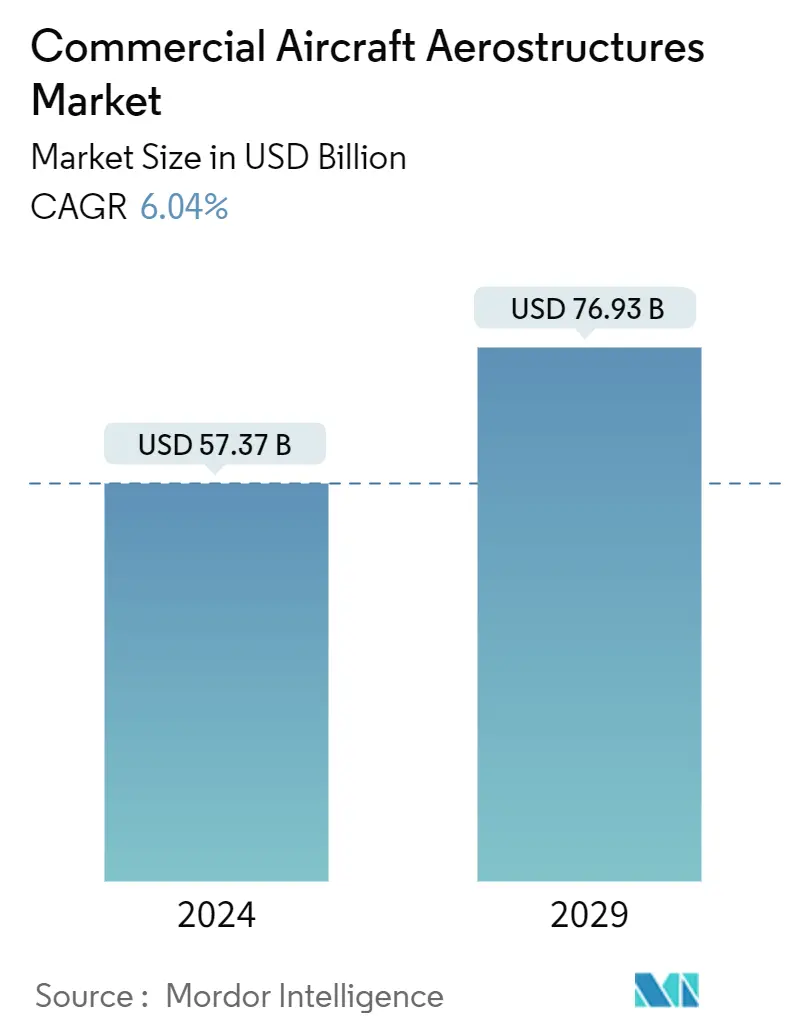
| Study Period | 2019 - 2029 |
| Market Size (2024) | USD 57.37 Billion |
| Market Size (2029) | USD 76.93 Billion |
| CAGR (2024 - 2029) | 6.04 % |
| Fastest Growing Market | Asia Pacific |
| Largest Market | North America |
Major Players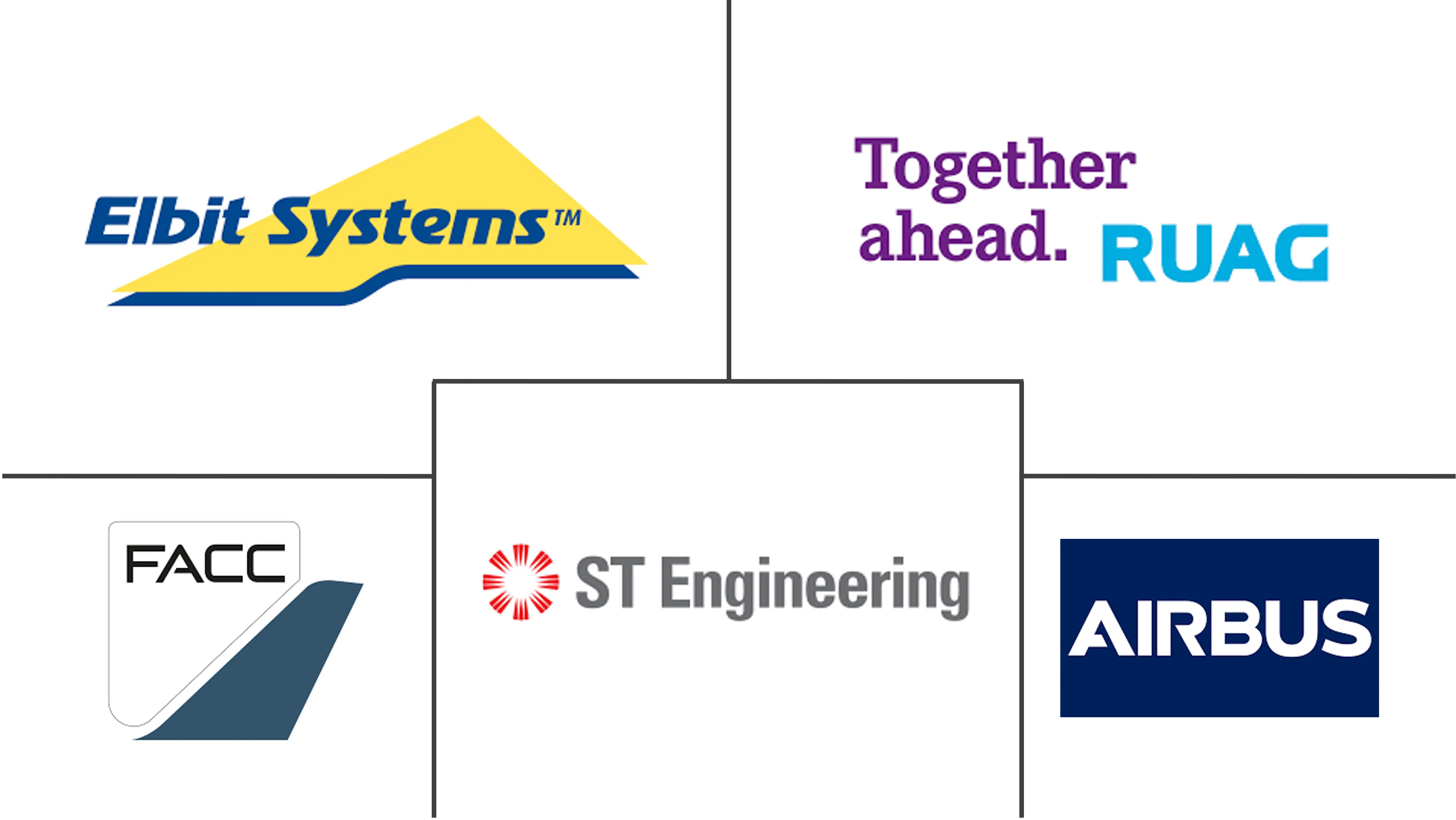
*Disclaimer: Major Players sorted in no particular order |
Commercial Aircraft Aerostructures Market Analysis
The Commercial Aircraft Aerostructures Market size is estimated at USD 57.37 billion in 2024, and is expected to reach USD 76.93 billion by 2029, growing at a CAGR of 6.04% during the forecast period (2024-2029).
The main driver for growth in the aircraft aerostructure market is increasing deliveries of commercial aircraft all over the world. The commercial aviation industry saw a significant increase in the number of new aircraft deployed. It is helping to support growth in the global aerostructure market as passengers have become more flexible over recent years. The use of composites and other advanced materials in aerostructures led to radical design changes in aircraft design. Their inherent high strength-to-weight ratio resulted in significant weight savings, thereby enhancing the fuel efficiency of the aircraft.
The market's growth is also due to an increase in tourism at the domestic and international levels, together with strict government rules on air safety.
However, the remuneration scope of the aeronautic sector is hindered by volatility in raw material prices. Technological innovations in the field, growing research & development investments in the aviation industry, and rising efforts of market players to develop advanced product ranges are adding traction to the industry expansion. Emerging technologies such as additive manufacturing and Automated Fiber Placement (AFP) techniques enhance the scope of integrating advanced materials into complex component designs while reducing the aircraft's turnaround time (TAT).
Commercial Aircraft Aerostructures Market Trends
OEMs Segment to Dominate Market Share During the Forecast Period
The significant increase in global passenger traffic drove airline operators to initiate procurement drives and place firm orders for new-generation aircraft. In 2022, Airbus delivered 676 commercial aircraft, while Boeing delivered 480. Aircraft OEMs are continuously honing their supply chain to reduce the backlog of orders and ensure on-time delivery to the airlines. Several new orders were placed during 2022, which encouraged associated aerostructure manufacturers and integrators alike to enhance their production capabilities. For instance, in June 2023, Indigo (India) ordered 500 Airbus A320neo family planes at the Paris Air Show.
Similarly, Air India (India) signed purchase agreements for 250 Airbus aircraft and 220 new Boeing jets worth USD 70 billion. Air India's orders include 70 widebody planes, comprising 34 A350-1000s and six A350-900s from Airbus, 20 B787 Dreamliners, and 10 B777Xs from Boeing. It also includes 140 Airbus A320neo, 70 Airbus A321neo, and 190 Boeing B737 MAX narrowbody aircraft. The airline also signed options to buy an additional 70 planes from Boeing, including 50 B737 MAXs and 20 B787 Dreamliners. Such procurement orders would drive the business prospects of the market players during the forecast period.
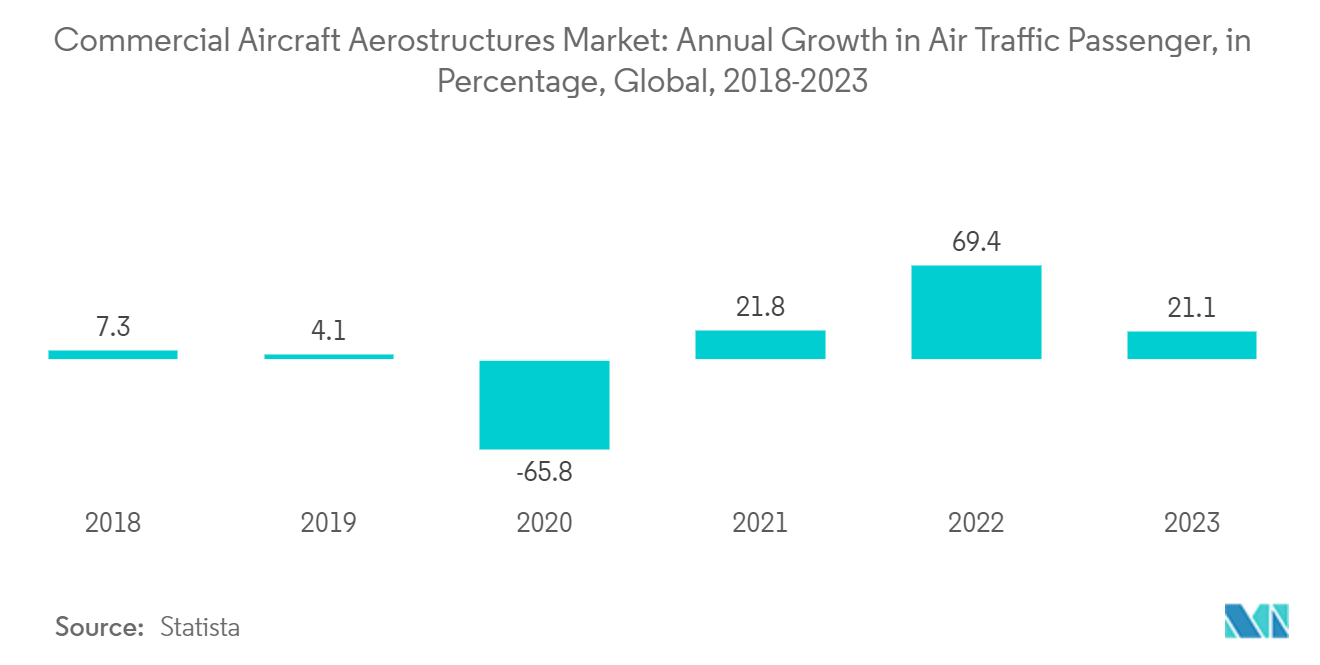
Asia-Pacific to Witness Highest Growth During the Forecast Period
The robust economic growth, coupled with favorable population and demographic profiles of the populace in developing countries, especially in the Asia-Pacific region, is driving the air passenger traffic in the region. It resulted in a steady increase in the demand for aircraft originating from Asia-Pacific. By 2025, China is forecasted to become the world's largest aviation market in terms of air traffic. India is forecasted to develop into the world's third-largest aviation market, while other countries, such as Indonesia and Thailand, are forecasted to enter the top 10 global markets.
The aviation manufacturing infrastructure is further supported by lower production costs, driving major aircraft OEMs to establish manufacturing hubs in the region. For instance, Airbus entrenched industrial partnerships with more than 600 firms in 15 countries in the region to ensure the supply of parts for Airbus aircraft. South Korea's KAL Aerospace and Korea Aerospace Industries (KAI) are key suppliers for Airbus and produce aerostructures, including parts of the A350 XWB fuselage, wing, cargo door, and landing gear, and the Sharklet wingtip device for the A320 and A330neo aircraft.
Moreover, in April 2023, Airbus is working to expand production of its best-selling A320 single-aisle jet and bolster sales in China. Airbus planned to build a second assembly line at its factory in China, and Beijing approved the old order for 160 aircraft.
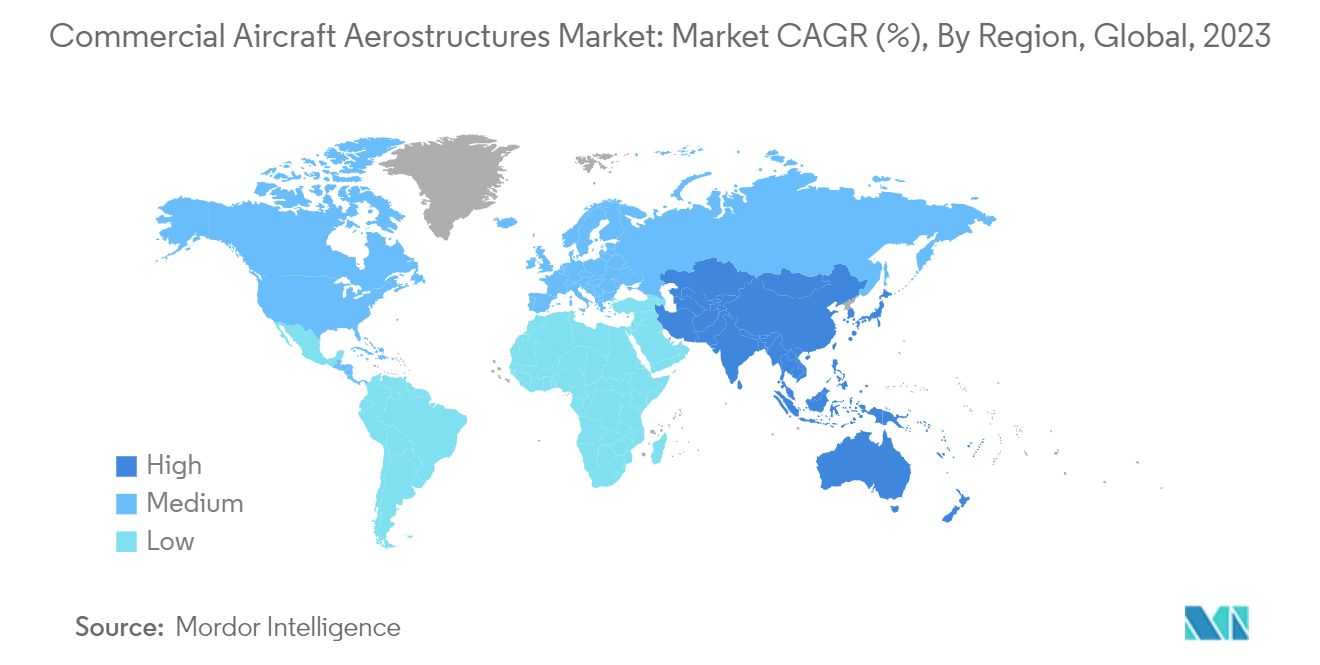
Commercial Aircraft Aerostructures Industry Overview
The commercial aircraft aerostructures market is fragmented and is witnessing the emergence of new market players that provide full lifecycle support, ranging from conceptual design, testing, and regulatory compliance certification. Since an aerostructure is required to withstand extreme operating conditions, the aerostructure materials are subjected to extensive testing to analyze and determine their performance parameters. Leading market players such as Elbit Systems Ltd., RUAG Group, Airbus SE, FACC AG, and Singapore Technologies Engineering Ltd. combine customer-specific design processes with their extensive metallic and composite structures knowledge, value engineering techniques, and design automation expertise to design cost-effective next-generation aerostructures.
Furthermore, the aerostructure designers are required to conduct manufacturing non-conformance, stress justifications, and design office dispositions after signatory approvals from concerned authorities. Such regulations may expose the market players to financial risks owing to the high R&D expenditure divested towards designing advanced materials for aerostructure construction. For instance, in April 2023, Leonardo S.p.A (Italy) entered into a partnership with Cisco Technology to develop joint technology projects. The partnership aims to develop joint products and solutions as a green transition to secure logistics and transportation solutions.
Similarly, in June 2021, Magellan Aerospace (UK) signed an agreement with Airbus to extend the contract to supply titanium and aluminum structural wing components. The components are supplied from Magellan's manufacturing units located throughout India and Europe.
Commercial Aircraft Aerostructures Market Leaders
-
FACC AG
-
Elbit Systems Ltd.
-
RUAG Group
-
Airbus SE
-
Singapore Technologies Engineering Ltd.
*Disclaimer: Major Players sorted in no particular order
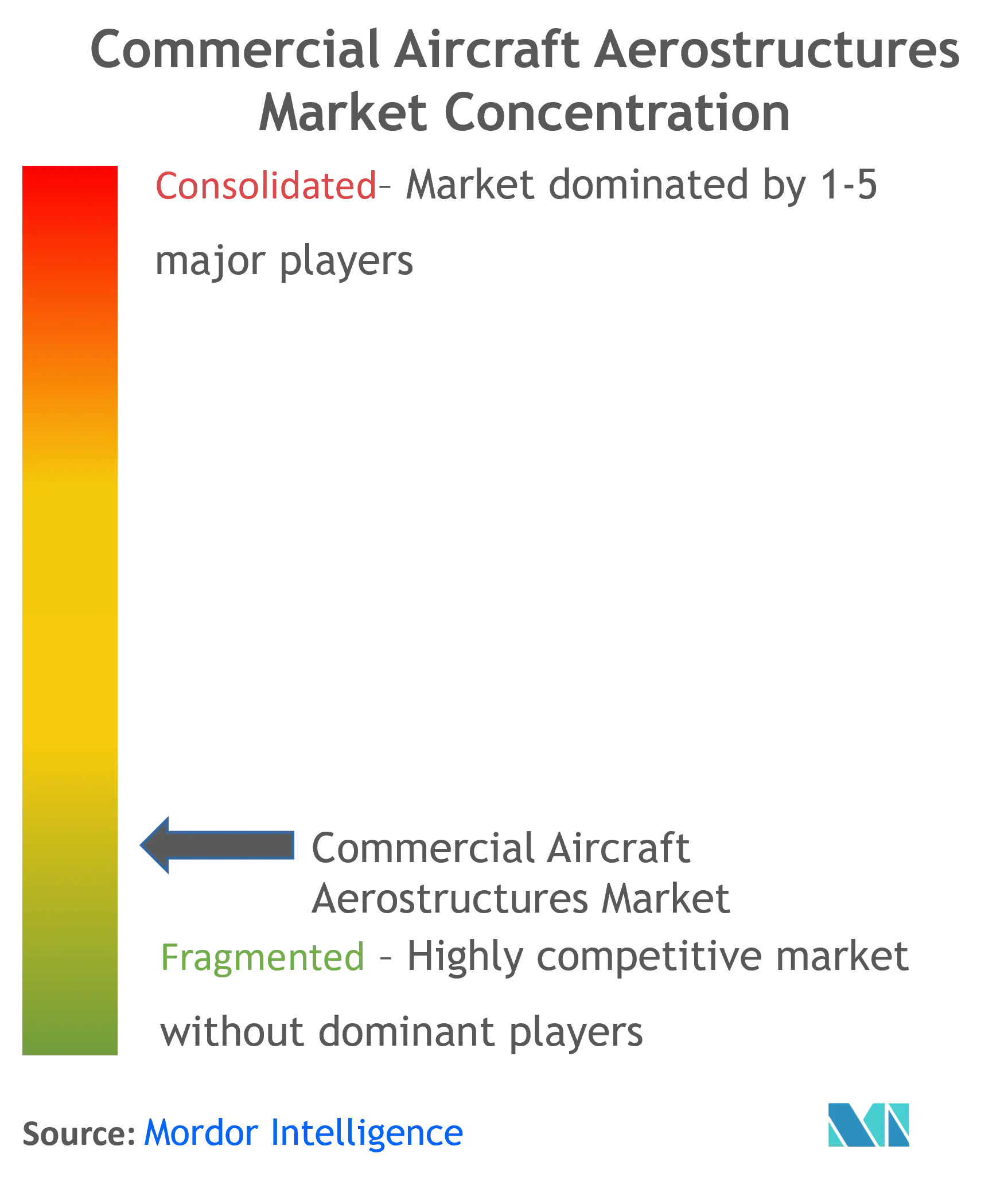
Commercial Aircraft Aerostructures Market News
- March 2023: Magellan Aerospace signed a significant long-term agreement extension with Collins Aerospace (RTX Corporation) to manufacture complex magnesium and aluminum castings for various military and commercial aerospace platforms.
- January 2023: General Atomics Aeronautical Systems, Inc. (GA-ASI) and Bharat Forge Limited signed a partnership to manufacture main landing gear components, subassemblies, and assemblies of remotely piloted aircraft.
Commercial Aircraft Aerostructures Market Report - Table of Contents
1. INTRODUCTION
- 1.1 Study Assumptions
- 1.2 Scope of the Study
2. RESEARCH METHODOLOGY
3. EXECUTIVE SUMMARY
4. MARKET DYNAMICS
- 4.1 Market Overview
- 4.2 Market Drivers
- 4.3 Market Restraints
-
4.4 Industry Attractiveness - Porter's Five Forces Analysis
- 4.4.1 Bargaining Power of Suppliers
- 4.4.2 Bargaining Power of Buyers/Consumers
- 4.4.3 Threat of New Entrants
- 4.4.4 Threat of Substitute Products
- 4.4.5 Intensity of Competitive Rivalry
5. MARKET SEGMENTATION
-
5.1 Material
- 5.1.1 Alloys
- 5.1.2 Composites
- 5.1.3 Metals
-
5.2 End-user
- 5.2.1 OEMs
- 5.2.2 Aftermarket
-
5.3 Geography
- 5.3.1 North America
- 5.3.1.1 United States
- 5.3.1.2 Canada
- 5.3.2 Europe
- 5.3.2.1 Germany
- 5.3.2.2 United Kingdom
- 5.3.2.3 France
- 5.3.2.4 Italy
- 5.3.2.5 Russia
- 5.3.2.6 Rest of Europe
- 5.3.3 Asia Pacific
- 5.3.3.1 China
- 5.3.3.2 India
- 5.3.3.3 Japan
- 5.3.3.4 South Korea
- 5.3.3.5 Australia
- 5.3.3.6 Rest of Asia-Pacific
- 5.3.4 Latin America
- 5.3.4.1 Brazil
- 5.3.4.2 Mexico
- 5.3.4.3 Rest of Latin America
- 5.3.5 Middle-East and Africa
- 5.3.5.1 United Arab Emirates
- 5.3.5.2 Saudi Arabia
- 5.3.5.3 Turkey
- 5.3.5.4 South Africa
- 5.3.5.5 Rest of Middle-East and Africa
6. COMPETITIVE LANDSCAPE
- 6.1 Vendor Market Share
-
6.2 Company Profiles
- 6.2.1 Airbus SE
- 6.2.2 Elbit Systems Ltd.
- 6.2.3 Singapore Technologies Engineering Ltd.
- 6.2.4 RUAG Group
- 6.2.5 FACC AG
- 6.2.6 Aviation Industry Corporation of China, Ltd
- 6.2.7 Aernnova Aerospace S.A.
- 6.2.8 Cyient
- 6.2.9 Hexcel Corporation
- 6.2.10 Leonardo S.p.A
- 6.2.11 Magellan Aerospace
- 6.2.12 Melrose Industries PLC
- 6.2.13 The Boeing Company
- 6.2.14 SABCA
- 6.2.15 The NORDAM Group LLC
- *List Not Exhaustive
7. MARKET OPPORTUNITIES AND FUTURE TRENDS
** Subject To AvailablityCommercial Aircraft Aerostructures Industry Segmentation
The term aerostructures encompasses all the structural components of an airframe. Aerostructures are required to withstand extreme conditions, ranging from prolonged exposure to extreme temperature variations, foreign object impact, and structural fatigue due to extreme loading cycles. Any aerostructure is an assembly of several structural members constructed primarily from either or all the following materials: alloys, metals, and composites.
The commercial aircraft aerostructures market is segmented by material, end-user, and geography. The commercial aircraft aerostructures market is segmented by material into alloys, composites, and metals. By end-user, the market is segmented into OEMs and aftermarkets. The report also covers the market sizes and forecasts for the commercial aircraft aerostructures market in major countries across different regions. For each segment, the market size is provided in terms of value (USD).
| Material | Alloys | |
| Composites | ||
| Metals | ||
| End-user | OEMs | |
| Aftermarket | ||
| Geography | North America | United States |
| Canada | ||
| Geography | Europe | Germany |
| United Kingdom | ||
| France | ||
| Italy | ||
| Russia | ||
| Rest of Europe | ||
| Geography | Asia Pacific | China |
| India | ||
| Japan | ||
| South Korea | ||
| Australia | ||
| Rest of Asia-Pacific | ||
| Geography | Latin America | Brazil |
| Mexico | ||
| Rest of Latin America | ||
| Geography | Middle-East and Africa | United Arab Emirates |
| Saudi Arabia | ||
| Turkey | ||
| South Africa | ||
| Rest of Middle-East and Africa |
Commercial Aircraft Aerostructures Market Research FAQs
How big is the Commercial Aircraft Aerostructures Market?
The Commercial Aircraft Aerostructures Market size is expected to reach USD 57.37 billion in 2024 and grow at a CAGR of 6.04% to reach USD 76.93 billion by 2029.
What is the current Commercial Aircraft Aerostructures Market size?
In 2024, the Commercial Aircraft Aerostructures Market size is expected to reach USD 57.37 billion.
Who are the key players in Commercial Aircraft Aerostructures Market?
FACC AG, Elbit Systems Ltd., RUAG Group, Airbus SE and Singapore Technologies Engineering Ltd. are the major companies operating in the Commercial Aircraft Aerostructures Market.
Which is the fastest growing region in Commercial Aircraft Aerostructures Market?
Asia Pacific is estimated to grow at the highest CAGR over the forecast period (2024-2029).
Which region has the biggest share in Commercial Aircraft Aerostructures Market?
In 2024, the North America accounts for the largest market share in Commercial Aircraft Aerostructures Market.
What years does this Commercial Aircraft Aerostructures Market cover, and what was the market size in 2023?
In 2023, the Commercial Aircraft Aerostructures Market size was estimated at USD 53.90 billion. The report covers the Commercial Aircraft Aerostructures Market historical market size for years: 2019, 2020, 2021, 2022 and 2023. The report also forecasts the Commercial Aircraft Aerostructures Market size for years: 2024, 2025, 2026, 2027, 2028 and 2029.
Aerostructures Industry Report
Statistics for the 2024 Aerostructures market share, size and revenue growth rate, created by Mordor Intelligence™ Industry Reports. Aerostructures analysis includes a market forecast outlook 2029 and historical overview. Get a sample of this industry analysis as a free report PDF download.



